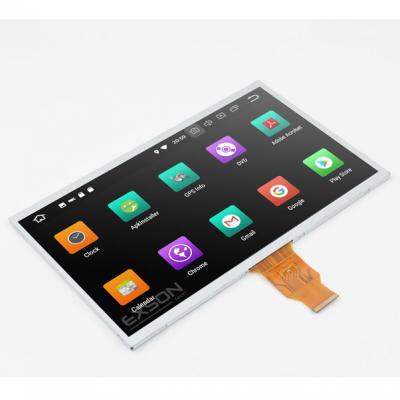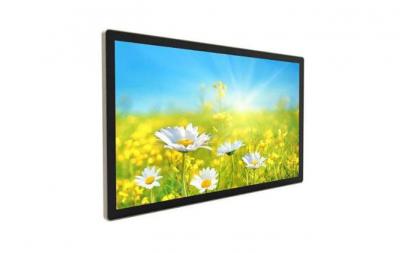Resistive LCD is an inductive liquid crystal display device capable of receiving input signals from contacts and other inputs. The resistive LCD locates the touch point through the pressure difference between two layers of conductive materials (such as ITO coatings). These two layers of materials are respectively coated on the opposite surfaces of a film and glass. When a touch operation occurs, the ITO under the film can contact the ITO coating on the glass layer, resulting in a change in resistance, which then triggers signal transmission and processing.
Simple structure, lower cost
Can be activated by any object that applies pressure due to its pressure-applying function
Resistant to water/dirt
Lower power consumption
Different input methods
Resistive LCD supports multiple methods such as fingers, styluses, or other objects that apply pressure, while capacitive LCD display only supports body touch.
Different surface materials and durability
Resistive LCD is film+glass, capacitive is glass+glass/glass+film; surface hardness differs, resistive is easily damaged when cracked, while capacitive can still work with small cracks.
Different anti-interference abilities
Capacitive LCD display is more sensitive and thus has poorer anti-interference abilities.
Touch detection
When a user touches the screen with a finger or other object, the two layers of conductive materials contact at the touch point, causing a change in resistance at that point.
Signal transmission
The change in resistance is detected by sensors and converted into electrical signals, which are then transmitted to the processor via conversion circuits.
Position calculation
The processor receives the signals and performs computations to determine the exact location of the touch point (X, Y coordinates).
Interface response
Based on the location information of the touch point, the system drives the corresponding connected devices or software interfaces to complete the user's operational instructions.
 Exson Tech In-Vehicle LCD Module: Leading a New Chapter in Automotive DisplaysJuly 1, 2024In today's rapidly developing automotive industry, in-car displays have become a key element in enhancing the driving experience and intelligent level. Among many in-car display technologies, LCD ...view
Exson Tech In-Vehicle LCD Module: Leading a New Chapter in Automotive DisplaysJuly 1, 2024In today's rapidly developing automotive industry, in-car displays have become a key element in enhancing the driving experience and intelligent level. Among many in-car display technologies, LCD ...view Innovations in Industrial TFT Display Technology: High Brightness, High Resolution, and BeyondMay 9, 2024With the continuous development of industrial automation and the improvement of the level of intelligence, industrial TFT display technology is also constantly innovating and progressing. High brightn...view
Innovations in Industrial TFT Display Technology: High Brightness, High Resolution, and BeyondMay 9, 2024With the continuous development of industrial automation and the improvement of the level of intelligence, industrial TFT display technology is also constantly innovating and progressing. High brightn...view The Difference Between LCD and LEDSeptember 26, 2022Customers often ask us about the difference between LCD and LED. Seen below will explain it in detail for you.1. Brightness: the response speed of a single element of the LED display is 1000 times tha...view
The Difference Between LCD and LEDSeptember 26, 2022Customers often ask us about the difference between LCD and LED. Seen below will explain it in detail for you.1. Brightness: the response speed of a single element of the LED display is 1000 times tha...view How Medical LCD Displays Are Transforming Patient CareJanuary 25, 2024In today's fast-paced world, technological advancements continue to revolutionize almost every industry, and healthcare is no exception. Among the notable innovations, medical LCD displays have be...view
How Medical LCD Displays Are Transforming Patient CareJanuary 25, 2024In today's fast-paced world, technological advancements continue to revolutionize almost every industry, and healthcare is no exception. Among the notable innovations, medical LCD displays have be...view Navigating the Future: The Wonders of LCD Touch ScreensNovember 17, 2023In the ever-expanding landscape of interactive technology, LCD touch screens have become the unsung heroes, transforming the way we engage with our digital devices. From smartphones and tablets to int...view
Navigating the Future: The Wonders of LCD Touch ScreensNovember 17, 2023In the ever-expanding landscape of interactive technology, LCD touch screens have become the unsung heroes, transforming the way we engage with our digital devices. From smartphones and tablets to int...view Characteristics and Advantages of LCD Bar-type LCD ScreensAugust 4, 2023The technology of LCD liquid crystal displays is developing rapidly, and LCD bar-type LCD screens are currently popular new products in the market. So what is a bar-type LCD screen?An LCD bar-type LCD...view
Characteristics and Advantages of LCD Bar-type LCD ScreensAugust 4, 2023The technology of LCD liquid crystal displays is developing rapidly, and LCD bar-type LCD screens are currently popular new products in the market. So what is a bar-type LCD screen?An LCD bar-type LCD...view Call us on:
Call us on:  Email Us:
Email Us:  2F-M1 XiaWei Industrial Park, GuanLan, LongHua District, SZ, China
2F-M1 XiaWei Industrial Park, GuanLan, LongHua District, SZ, China